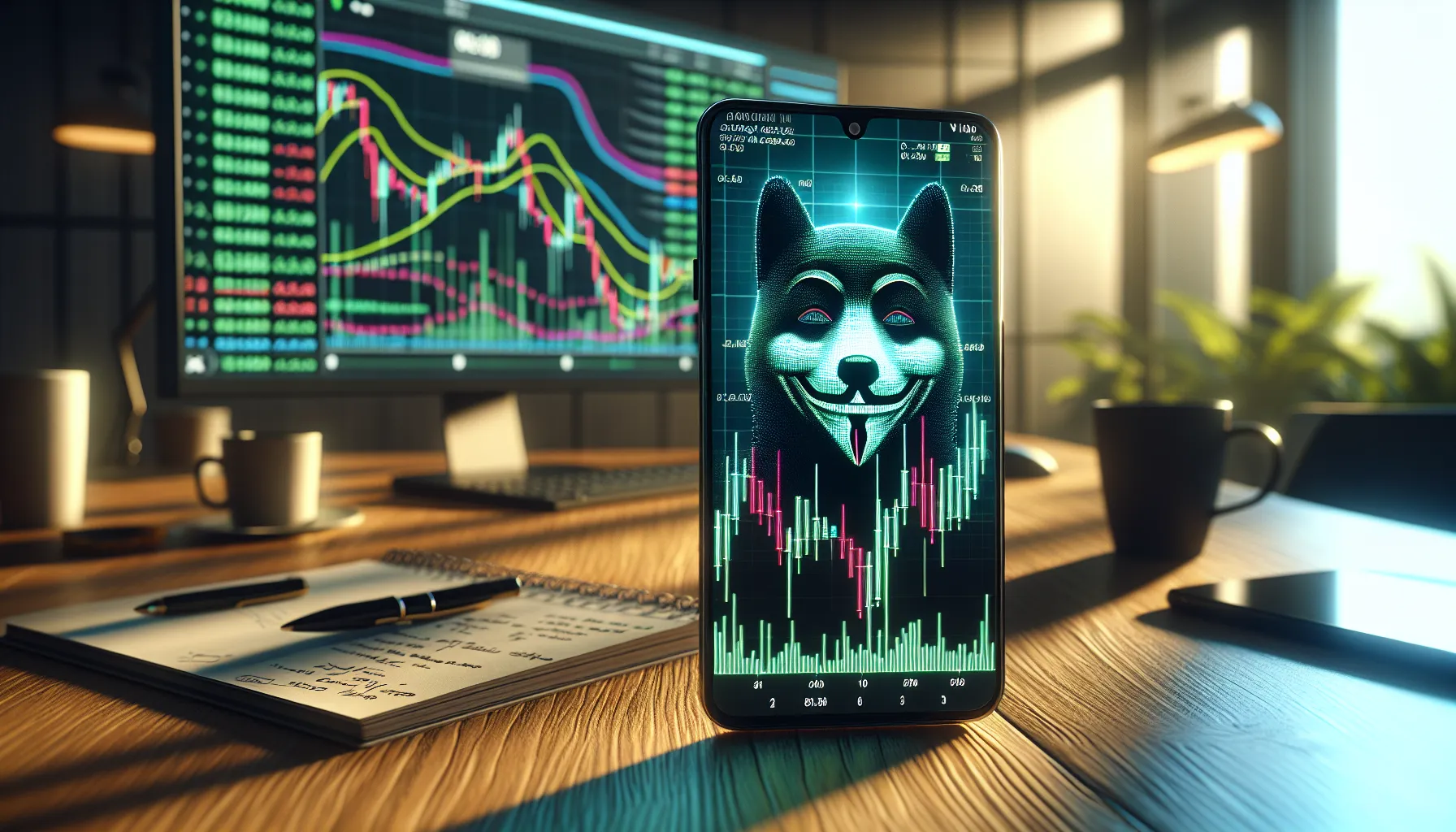If you’ve been watching the meme coin space, Floki Inu probably caught your attention. Named after Elon Musk’s Shiba Inu dog, this token burst onto the scene with bold marketing and an ambitious vision that goes beyond simple speculation. But here’s the thing, predicting cryptocurrency prices is never simple, especially when you’re dealing with a token that exists somewhere between meme culture and actual utility.
You’re likely here because you want to know where Floki Inu is headed. Maybe you’re already holding some tokens, or perhaps you’re considering whether this is the right time to enter. Either way, understanding the factors that move this token’s price is absolutely critical before you make any decisions with your money.
This forecast draws on market fundamentals, historical patterns, and the specific developments within Floki’s ecosystem to give you a realistic picture. I won’t sugarcoat things or make promises about moon shots. What I will do is walk you through what affects Floki’s price, where it’s been, and where credible analysis suggests it might go over the next several years.
Key Takeaways
- Floki Inu token price forecast depends heavily on broader crypto market cycles, with Bitcoin’s performance serving as the primary driver of altcoin movements.
- The project differentiates itself from typical meme coins through utility developments like Valhalla metaverse game and FlokiFi DeFi ecosystem, though real adoption remains critical.
- Short-term forecasts for 2025-2026 suggest potential gains of 100-500% during bull market conditions, while medium-term outlooks anticipate significant corrections during the next bear cycle.
- Floki Inu token price faces substantial risks including fierce meme coin competition, execution challenges on utility products, and regulatory uncertainties affecting the broader crypto space.
- Investment strategy should prioritize strict position sizing, clear profit-taking levels, and recognition that Floki represents high-risk speculation rather than traditional investing.
Understanding Floki Inu: Market Position and Fundamentals

Floki Inu launched in June 2021, riding the wave of meme coin popularity that followed Dogecoin and Shiba Inu’s success. But unlike many copycat projects that faded quickly, Floki managed to carve out a distinct identity. The project positions itself as “the people’s cryptocurrency” and has built an ecosystem that includes multiple use cases beyond pure speculation.
At its core, Floki operates on both Ethereum and Binance Smart Chain through a bridge mechanism. This dual-chain approach gives holders flexibility and reduces dependency on a single network’s gas fees and congestion. The token’s market capitalization has fluctuated significantly, as you’d expect with any cryptocurrency, but it has maintained a position within the top 100 to 150 cryptocurrencies by market cap throughout much of its existence.
What sets Floki apart from typical meme coins is its focus on building actual utility. The project has developed several initiatives including Valhalla (a play-to-earn metaverse game), FlokiFi (a DeFi ecosystem), and the University of Floki (educational content). Whether these products gain meaningful adoption remains an open question, but their existence signals intent beyond riding meme status alone.
The tokenomics play a significant role in understanding potential price movements. Floki implemented a burn mechanism and redistributes a portion of transaction fees to holders. The supply is capped, though the circulating supply continues to represent a substantial portion of the total. Large supply numbers mean that significant price increases require equally significant capital inflows or aggressive burning mechanisms.
Your assessment of Floki should recognize it exists in a hybrid category. It has the viral marketing and community-driven aspects of a meme coin, but also attempts to build tangible products. This positioning creates both opportunities and risks that will influence price trajectories.
Historical Price Performance and Key Milestones
Looking backward gives you context for forecasting forward. Floki’s price history shows the wild swings typical of newer cryptocurrencies, particularly those with meme coin origins.
After launching in mid-2021, Floki experienced its first major rally in late 2021, coinciding with Bitcoin’s push toward all-time highs and broader altcoin season. The token reached its all-time high in November 2021, propelled by aggressive marketing campaigns that included billboard advertisements in major cities and public transportation systems worldwide. That peak represented returns of over 1,000% for early adopters, but it was short-lived.
The 2022 bear market hit Floki hard, as it did most cryptocurrencies. The token lost over 90% of its value from peak to trough, testing the resolve of its community. Many similar projects disappeared entirely during this period, but Floki’s team continued development work on its ecosystem products. This consistent building during difficult market conditions helped maintain some level of credibility.
Throughout 2023, Floki showed resilience alongside the broader market recovery. Several catalysts drove short-term price spikes: major exchange listings, partnership announcements, and updates on the Valhalla game development. Each of these events created temporary price bumps, though sustaining those gains proved difficult without continued market momentum.
By late 2023 and into 2024, the pattern became clearer. Floki’s price movements correlated strongly with Bitcoin’s direction and overall risk sentiment in crypto markets. When Bitcoin rallied, Floki often outperformed on the upside. When Bitcoin corrected, Floki typically fell harder. This high-beta characteristic is something you need to factor into your expectations.
The key milestones that actually moved the price weren’t just tweets or memes, they were tangible developments. The launch of FlokiFi Locker, listings on top-tier exchanges like Binance and Coinbase, and the beta release of Valhalla all corresponded with positive price action. This suggests that while community enthusiasm matters, real product delivery carries more weight for sustained price appreciation.
Factors Influencing Floki Inu Price Movements
To forecast where Floki is heading, you need to understand what actually moves its price. Multiple forces work simultaneously, sometimes pulling in opposite directions.
Market Sentiment and Community Engagement
Floki’s community remains one of its strongest assets. The “Floki Vikings” actively promote the project across social media, creating organic marketing that many projects would pay dearly for. When community engagement is high, measured through social mentions, Twitter activity, and holder growth, the token typically performs better.
But sentiment is fickle. Meme coins live and die by attention, and maintaining that attention requires constant effort. Floki has managed this better than most, but you’re still dealing with a token where perception often matters more than fundamentals. Negative sentiment can spread just as quickly as positive, and price drops can accelerate when holders rush for exits.
The influence of broader cultural moments shouldn’t be underestimated either. Elon Musk’s tweets about his dog Floki have historically caused price spikes, even though Musk has no official connection to the project. You can’t forecast these moments, but you can recognize that external celebrity attention creates volatility.
Broader Cryptocurrency Market Trends
Floki doesn’t exist in isolation. Bitcoin’s price action sets the tone for the entire market, and when Bitcoin enters a bull phase, capital flows into riskier altcoins like Floki. Conversely, during Bitcoin corrections or bear markets, smaller tokens typically suffer disproportionately.
Regulatory developments also matter significantly. Increased regulatory clarity in major markets could legitimize the cryptocurrency space and bring new capital. On the other hand, harsh regulatory crackdowns could scare away retail investors who form Floki’s primary base.
The overall crypto market cycle is probably the single biggest factor in Floki’s price trajectory. If we’re entering a prolonged bull market, Floki stands to benefit considerably. If we face another extended bear period, no amount of project development will prevent significant price declines.
Utility Developments and Ecosystem Growth
This is where Floki attempts to separate itself from pure meme coins. The success or failure of Valhalla, the metaverse game, could significantly impact long-term price prospects. If the game attracts a substantial player base and creates genuine demand for Floki tokens as in-game currency, that changes the fundamental value proposition.
FlokiFi’s growth matters too. If the DeFi products gain traction and lock up significant amounts of Floki tokens, that reduces circulating supply and could create upward price pressure. The key word is “if”, many crypto projects announce ambitious products that never achieve meaningful adoption.
Partnerships and exchange listings continue to play a role. Each major exchange listing exposes Floki to new potential buyers. Strategic partnerships with established companies or other crypto projects lend credibility and can open new use cases. You should watch for these announcements, as they often serve as short-term catalysts.
Token burns and buybacks also influence supply dynamics. If the project commits to aggressive token burning tied to revenue from its products, that creates a deflationary pressure that supports price appreciation over time.
Short-Term Price Forecast: 2025-2026
Let’s get into specific projections, starting with the near term. These forecasts assume Bitcoin continues its current cycle trajectory and no major catastrophic events derail the crypto market entirely.
For 2025, you’re looking at a continuation of the current bull cycle that began in late 2023. Historically, Bitcoin halving events (the most recent occurred in April 2024) lead to bull markets that peak roughly 12-18 months afterward. If this pattern holds, mid-to-late 2025 could see peak euphoria in crypto markets.
Under a bullish scenario where Bitcoin reaches new all-time highs and altcoin season fully materializes, Floki could reasonably test its previous all-time high levels or potentially exceed them. This would represent gains of 300-500% from current levels for those entering at the right time. The community’s marketing prowess and any successful product launches could fuel such a move.
A more moderate scenario, where Bitcoin rises steadily but without extreme euphoria, suggests Floki gains of 100-200% through 2025. This assumes continued development progress, maintained community engagement, and no major competitive threats from newer meme coins capturing market attention.
The bearish case for 2025-2026 involves Bitcoin peaking earlier than expected or regulatory crackdowns dampening retail enthusiasm. In this scenario, Floki might see modest gains of 20-50% at peak before entering a correction phase. If Bitcoin enters a bear market in 2026, Floki would likely give back most gains and trade sideways to down.
Your personal strategy for this timeframe should account for typical bull market psychology. Prices rarely move in straight lines, and even during strong uptrends, you’ll see 30-50% corrections that shake out weak hands. Setting realistic profit-taking levels and not getting caught up in “moon talk” will serve you better than hoping for 10x or 100x returns.
One wildcard for this period is the launch timeline and reception of Valhalla. If the game launches successfully and gains traction among play-to-earn enthusiasts, that could accelerate price appreciation beyond what macro factors alone would suggest.
Medium-Term Price Forecast: 2027-2028
The 2027-2028 timeframe presents more uncertainty because it likely spans the transition from bull to bear and potentially the early stages of recovery. Your expectations need to adjust accordingly.
If historical patterns repeat, 2026-2027 would mark a bear market following the post-halving bull run. This means 2027 could be challenging for all cryptocurrencies, including Floki. During bear markets, attention and capital dry up. Meme coins suffer particularly during these periods because they rely heavily on retail enthusiasm, which evaporates when prices are falling.
The realistic scenario for 2027 involves Floki trading significantly below its 2025 peak, potentially down 60-80% from those highs. This isn’t a judgment on Floki specifically but rather an acknowledgment of how crypto market cycles work. The key question becomes whether Floki maintains a higher floor than it established in previous bear markets, which would indicate growing fundamental strength.
What happens during the bear market determines 2028 prospects. If the Floki team continues building and the ecosystem products actually retain users even though poor price action, that sets up a stronger position for the next cycle. Projects that survive bear markets with active development and maintained communities often perform exceptionally well in subsequent bull runs.
By 2028, assuming we’re entering the early stages of the next bull cycle (driven by the 2028 Bitcoin halving), you could see Floki beginning a recovery. Early-stage bull markets offer excellent risk-reward ratios because prices are depressed and sentiment is still cautious. A reasonable projection for late 2028 is that Floki recovers 50-100% from its 2027 lows but remains below its previous cycle peak.
The medium term is where Floki’s actual product adoption becomes critical. If Valhalla, FlokiFi, and other ecosystem components haven’t gained real users by 2027-2028, the project’s credibility will be severely damaged. Conversely, if these products show growing engagement metrics even though poor price action, that validates the utility thesis and supports higher valuations in the next cycle.
Your investment timeline matters significantly here. If you’re looking at Floki as a medium-term hold, you need the stomach to weather a likely bear market in 2026-2027. Many investors who buy during euphoric periods panic sell during subsequent corrections, locking in losses. Understanding this cycle psychologically prepares you for what’s coming.
Long-Term Price Forecast: 2029-2030
Looking out to 2029-2030 means making educated guesses about the crypto landscape five years from now. The uncertainty multiplies, but we can still identify likely scenarios based on current trajectories.
The most optimistic long-term case assumes cryptocurrency achieves significantly broader mainstream adoption by 2030. In this scenario, projects with real utility and engaged communities thrive while pure meme coins fade. If Floki successfully transitions into a legitimate utility token with thriving gaming and DeFi ecosystems, it could trade at multiples of its previous all-time high by 2029-2030.
In numerical terms, this scenario could see Floki reaching price levels 500-1000% above its 2021 peak during the next major bull cycle (expected around 2029). This isn’t as crazy as it sounds if you consider that many current top tokens were worth pennies five years ago. The requirement is that Floki proves its utility thesis and retains relevance as the market matures.
A more conservative long-term outlook suggests Floki maintains its position as a mid-tier meme coin with modest utility elements. In this scenario, the token benefits from overall crypto market growth but doesn’t break out into top-tier status. You’d be looking at prices that roughly match or modestly exceed previous cycle highs, respectable returns for patient holders but not life-changing wealth.
The bearish long-term case is that Floki becomes irrelevant. New meme coins constantly emerge, and attention is finite. If the ecosystem products fail to gain traction and community engagement wanes, Floki could fade into obscurity like countless crypto projects before it. Many tokens that seemed promising in 2021 are barely traded today.
Regulatory developments will significantly shape these long-term outcomes. If regulations crack down specifically on meme tokens or tokens perceived as securities, Floki could face serious challenges. Alternatively, clear regulatory frameworks that legitimize properly structured crypto projects could benefit Floki if it adapts appropriately.
The broader technological landscape matters too. If gaming and metaverse adoption accelerates as many expect, Floki’s positioning in that space could prove prescient. If those sectors fail to materialize or different technologies win out, Floki’s utility thesis weakens considerably.
Your long-term outlook on Floki should honestly assess whether you believe in the team’s execution ability and the project’s fundamental premise. Price forecasts five years out are essentially bets on those factors plus overall crypto market trajectory. Nobody knows for certain, but understanding the variables helps you make informed decisions rather than gambling on hype.
Risks and Challenges for Price Growth
Before you get too excited about potential price gains, you need to confront the serious risks facing Floki Inu. Every investment has downside scenarios, and Floki’s particular characteristics create specific vulnerabilities.
Competition in the meme coin space is perhaps the most immediate threat. New dog-themed, cat-themed, and celebrity-endorsed tokens launch constantly. Each one competes for the same pool of retail attention and capital. If a new meme coin captures the zeitgeist the way Dogecoin did in 2021 or Shiba Inu did shortly after, Floki could quickly become yesterday’s news. Attention is the lifeblood of meme tokens, and it’s notoriously fickle.
Execution risk on the utility side is equally concerning. The gap between announcing products and delivering successful products is where many crypto projects fail. Valhalla has been in development for years, and if it launches to tepid reception or fails to retain players, that severely damages Floki’s differentiation story. Building games is hard: building blockchain games that people actually enjoy playing is even harder.
The tokenomics present inherent challenges too. The large token supply means significant price appreciation requires enormous capital inflows or aggressive burning. Compare Floki’s supply metrics to Bitcoin or Ethereum, and you see why reaching dollar-parity or even cent-parity prices would require valuations that might not be realistic given the project’s actual economic activity.
Regulatory risk looms over all cryptocurrencies, but particularly those that began as meme tokens. Regulators globally are scrutinizing crypto projects more closely. If Floki’s structure or operations draw regulatory action, that could tank the price and limit future prospects. The project operates across multiple jurisdictions, which compounds regulatory complexity.
Liquidity concerns are real during market downturns. When everyone rushes to sell and few want to buy, prices can collapse faster than you’d expect. Floki’s liquidity depth varies significantly across different exchanges and trading pairs. During panic selling, you might not be able to exit positions at prices you consider reasonable.
Team and centralization risks also exist. While Floki positions itself as community-driven, key decisions still rest with a relatively small group. If core team members lose interest, have conflicts, or make poor strategic choices, that damages the project’s prospects. The pseudonymous nature of many crypto teams makes accountability difficult.
Technical risks, while less dramatic, shouldn’t be ignored. Smart contract vulnerabilities, bridge exploits, or failures in the dual-chain architecture could result in loss of funds or confidence. Every additional complexity in a token’s technical structure creates more potential failure points.
You also face the psychological risk of holding through volatility. Floki’s price can swing 20-30% in a single day. If you’re not emotionally prepared for that volatility, you’ll make poor decisions, selling bottoms and buying tops. This risk is about you, not the token itself, but it’s probably the one that causes the most actual losses for retail investors.
Investment Considerations for Floki Inu
If you’re considering putting money into Floki, you need a clear-eyed strategy that goes beyond hoping for price pumps.
First, determine your risk tolerance honestly. Floki sits at the high-risk end of the cryptocurrency spectrum, which itself is high-risk compared to traditional investments. If you can’t afford to lose the money you’re considering investing, don’t invest it. That’s not being dramatic, it’s being realistic about the range of outcomes. The money you put into Floki should be money you’ve already mentally categorized as “risk capital.”
Position sizing matters enormously. Even if you’re bullish on Floki’s prospects, it shouldn’t represent a huge percentage of your overall crypto portfolio, much less your total net worth. Many experienced crypto investors use a barbell strategy: core holdings in Bitcoin and Ethereum, with smaller speculative positions in higher-risk tokens like Floki. This approach lets you capture upside from moonshots while limiting damage from failures.
Timing your entry is tricky but important. Buying during euphoric pumps when everyone is talking about a token rarely works out well. Better entry points typically come during quiet periods or after corrections when sentiment has cooled. That said, trying to perfectly time the bottom is futile. Dollar-cost averaging, buying small amounts over time, reduces the impact of buying at poor prices.
Set clear profit-taking levels before you invest. Decide in advance at what price points you’ll sell portions of your position. This removes emotion from the decision when the time comes. Maybe you sell 25% if the price doubles, another 25% if it triples, and so on. Having a plan prevents you from holding through entire cycles without taking any gains.
Stay informed about project developments without getting caught in echo chambers. Follow Floki’s official channels for announcements, but also seek critical perspectives. Community Telegram and Discord channels tend toward excessive optimism, which clouds judgment. Balance project updates with broader market analysis to maintain perspective.
Consider tax implications of your trading strategy. Frequent trading can create significant tax liabilities, particularly in jurisdictions that treat each crypto-to-crypto trade as a taxable event. Sometimes the better move is holding through volatility rather than trying to trade every swing, purely from a tax efficiency standpoint.
Don’t invest based on social media hype or influencer recommendations. Many crypto influencers have financial incentives to promote certain tokens. Do your own research, understand what you’re buying, and make decisions based on your own analysis rather than someone else’s claims.
Think about your exit strategy plus to your entry. Will you hold for a specific time period? Sell at certain price targets? Exit if certain negative developments occur? Knowing when you’ll get out is as important as knowing when you’ll get in. Too many investors buy without any plan for selling, then watch their unrealized gains evaporate during downturns.
Finally, recognize that investing in something like Floki is speculating rather than investing in the traditional sense. You’re betting on attention, community strength, execution, and favorable market conditions all aligning. That’s different from investing in assets with predictable cash flows or proven business models. The potential returns are higher, but so is the probability of permanent loss of capital.
Conclusion
Forecasting Floki Inu’s price with precision is impossible, but understanding the factors that will drive its trajectory is absolutely possible. You’re looking at a token that combines meme coin characteristics with genuine attempts at utility building, operating in an inherently volatile market that moves in cycles.
The short-term outlook through 2025-2026 depends heavily on broader crypto market conditions and whether we see a full altcoin season. Medium-term prospects for 2027-2028 likely involve weathering a bear market, with survival and continued development being the key success metrics. Long-term possibilities through 2029-2030 rest on whether Floki’s ecosystem products achieve real adoption and the project maintains relevance in an increasingly competitive space.
Your decision to buy, hold, or avoid Floki should be based on honest assessment of the risks versus your personal financial situation and goals. This isn’t a blue-chip asset you buy and forget about. It requires active monitoring, strong risk management, and psychological preparation for extreme volatility.
The forecasts presented here represent reasonable scenarios based on current information and historical patterns, but they’re not guarantees. Market conditions change, projects evolve, and unexpected events routinely upend predictions. Use this analysis as one input among many in your decision-making process, not as a roadmap to certain profits.
What’s clear is that Floki has demonstrated more staying power than most meme coins. Whether that translates to price appreciation over your specific investment timeframe depends on factors both within and outside the project’s control. Your job is to understand those factors, manage your risk appropriately, and make decisions aligned with your own financial objectives rather than getting swept up in hype or fear.
Frequently Asked Questions
What is Floki Inu token and how does it differ from other meme coins?
Floki Inu is a cryptocurrency launched in June 2021, named after Elon Musk’s dog. Unlike typical meme coins, Floki builds actual utility through products like Valhalla (a metaverse game), FlokiFi (DeFi ecosystem), and educational content, positioning itself between meme culture and genuine use cases.
What is the Floki Inu price forecast for 2025?
Under a bullish scenario with strong Bitcoin performance, Floki could test or exceed its previous all-time high, representing potential gains of 300-500%. A moderate scenario suggests gains of 100-200%, while bearish conditions could yield modest 20-50% increases before corrections.
What factors most influence Floki Inu’s price movements?
Floki’s price is primarily driven by Bitcoin’s market cycles, community engagement strength, broader crypto sentiment, ecosystem product adoption (especially Valhalla game), major exchange listings, token burns, and occasionally celebrity mentions, particularly from Elon Musk regarding his dog.
Is Floki Inu a good long-term investment?
Floki represents a high-risk speculative investment. Long-term success depends on ecosystem product adoption, surviving crypto bear markets, maintaining community engagement, and navigating regulatory challenges. Only invest risk capital you can afford to lose, as meme coins face significant volatility and competition.
How do crypto market cycles affect altcoin prices like Floki?
Crypto markets move in cycles tied to Bitcoin halving events, typically peaking 12-18 months post-halving. During bull markets, altcoins like Floki often outperform Bitcoin. During bear markets, they typically drop 60-90%, making cycle timing crucial for investment strategy.
What are the biggest risks facing Floki Inu token?
Major risks include intense competition from new meme coins, execution failure on utility products like Valhalla, large token supply requiring massive capital for price growth, regulatory crackdowns, liquidity issues during downturns, and the inherent volatility of speculative assets.






